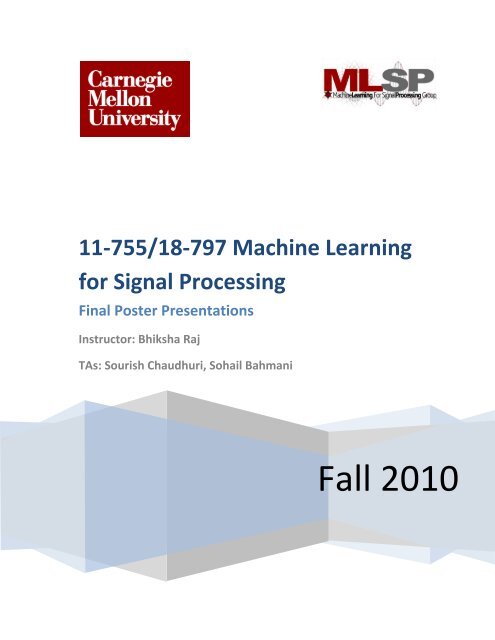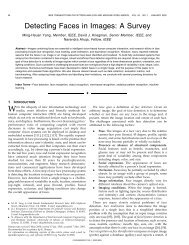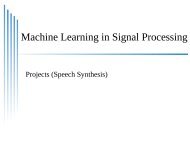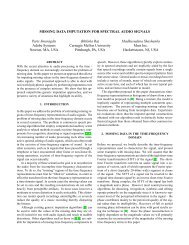11-755/18-797 Machine Learning for Signal Processing
11-755/18-797 Machine Learning for Signal Processing
11-755/18-797 Machine Learning for Signal Processing
You also want an ePaper? Increase the reach of your titles
YUMPU automatically turns print PDFs into web optimized ePapers that Google loves.
<strong>11</strong>-<strong>755</strong>/<strong>18</strong>-<strong>797</strong> <strong>Machine</strong> <strong>Learning</strong><br />
<strong>for</strong> <strong>Signal</strong> <strong>Processing</strong><br />
Final Poster Presentations<br />
Instructor: Bhiksha Raj<br />
TAs: Sourish Chaudhuri, Sohail Bahmani<br />
Fall 2010
UNSUPERVISED FACE CLUSTERING IN VIDEO<br />
Aaron Jaech, Andy Strat, Chenkai Xie<br />
Our goal is to make the tagging and indexing of faces in videos a one-click process. Faces are<br />
detected using Viola-Jones supplemented with a tracking algorithm. Since each face is highly similar<br />
to the faces on immediately adjacent frames it is possible to group images from the same individual<br />
together using a simple clustering algorithm. Since the number of faces per individual is often very<br />
large (15 frames per second ) it is possible to handle changes in pose, scene and lighting. After<br />
clustering the user is presented with one face from each individual <strong>for</strong> labeling.<br />
Originality: 1-5 (5 is highest):<br />
Completeness: 1-5 (5 is highest):<br />
Overall: 1-5 (5 is highest):<br />
<strong>11</strong>-<strong>755</strong>/<strong>18</strong>-<strong>797</strong> <strong>Machine</strong> <strong>Learning</strong> <strong>for</strong> <strong>Signal</strong> <strong>Processing</strong> 1
MULTI-RATE EVENT DETECTION FOR ENERGY-AWARE<br />
GREEN DESIGN FACILITIES: TECHNIQUES TO IMPROVE EVENT<br />
DETECTION IN NONINTRUSIVE SYSTEMS<br />
Amrita Anand, Kedar Mane, Rathi Munukur<br />
The buzz word in today's world is energy and energy management. Current trends show that the<br />
total world consumption of marketed energy will increase by 49 percent from 2007 to 2035. If<br />
consumers are given access to detailed data about their day-to-day power consumption they can<br />
make in<strong>for</strong>med decisions towards managing their own demand thus also achieving huge cost<br />
savings. One step to efficiently conserve energy is to first find the energy consumption by each<br />
appliance and then accordingly take steps to decrease the overall energy consumption.<br />
The objective of “Multi-rate Event Detection <strong>for</strong> Energy-Aware Green Design Facilities” is to<br />
detect the occurrence of events (on-off of appliances) in order to estimate the distribution of power<br />
consumption. This is an extension of “A Framework <strong>for</strong> Enabling Energy-Aware Facilities through<br />
Minimally-Intrusive Approaches” (thesis of Mario E. Berges) which aims at non-intrusive load<br />
monitoring i.e., load monitoring without the use of sub meters. Techniques such as multi-rate<br />
sampling are explored to improve accuracy of the detected events, apart from using the Generalized<br />
Likelihood Ratio algorithm. Different signatures are created to characterize the possible events by<br />
using a variety of different methods. These signature libraries are used to assist the detection of<br />
events by per<strong>for</strong>ming signature matching. This improves the accuracy of the detected events by<br />
eliminating false detections. An improvement of around 50% in the number of correct events<br />
detected was obtained while using multiple sampling as opposed to using a single sampling rate<br />
approach.<br />
Originality: 1-5 (5 is highest):<br />
Completeness: 1-5 (5 is highest):<br />
Overall: 1-5 (5 is highest):<br />
<strong>11</strong>-<strong>755</strong>/<strong>18</strong>-<strong>797</strong> <strong>Machine</strong> <strong>Learning</strong> <strong>for</strong> <strong>Signal</strong> <strong>Processing</strong> 2
DE-IDENTIFICATION OF SPEECH<br />
Bharat Kandoi, Bhaskar Adavi, Prashant Malani, Sahil Sapre<br />
Telephonic dialogues are a popular means of in<strong>for</strong>mation retrieval. However, they are also a hidden<br />
channel <strong>for</strong> the invasion of the end-users' privacy. One way of protecting people from privacy<br />
invasion is to de-identify the speaker's voice such that the speech still sounds natural and fully<br />
intelligible, yet does not reveal in<strong>for</strong>mation about the identity of the speaker.<br />
In this project, we propose a method of de-identifying voices using existing tools <strong>for</strong> voice<br />
conversion. This task entails both building a robust speaker ID system capable of identifying<br />
speakers’ voices and an algorithm to determine the trans<strong>for</strong>mation model that de-identifies speakers’<br />
voices while retaining intelligibility.<br />
We have designed a speaker ID system that builds models <strong>for</strong> the speakers’ voice using Gaussian<br />
mixture modeling. We base the models on three features of the speakers’ voice: the spectral<br />
parameters (mel-frequency cepstral coefficients), the non-zero fundamental frequencies (f0s) and the<br />
clustered MFCCs. We have achieved a reasonable accuracy in detecting unconverted voices with the<br />
SID.<br />
To trans<strong>for</strong>m voices, we use Festvox, a project that is part of the work at Carnegie Mellon<br />
University’s speech group. We define the ‘best’ trans<strong>for</strong>mation as the most de-identified yet fully<br />
comprehensible trans<strong>for</strong>mation of the input utterance. We choose the most de-identified<br />
trans<strong>for</strong>mation using a k-means clustering algorithm and selective cluster-elimination. Intelligibility is<br />
a subjective metric that is given to a high degree of variability when presented to different listeners.<br />
We propose a possible method of eliminating unintelligible trans<strong>for</strong>mations using software.<br />
Experimental results show a high degree of confusability when the speaker ID is presented with the<br />
voices trans<strong>for</strong>med using models selected by the clustering algorithm.<br />
Originality: 1-5 (5 is highest):<br />
Completeness: 1-5 (5 is highest):<br />
Overall: 1-5 (5 is highest):<br />
<strong>11</strong>-<strong>755</strong>/<strong>18</strong>-<strong>797</strong> <strong>Machine</strong> <strong>Learning</strong> <strong>for</strong> <strong>Signal</strong> <strong>Processing</strong> 3
EMOTION RECOGNITION AND SYNTHESIS IN SPEECH<br />
Dan Burrows, Ajay Ghadiyaram, Maxwell Jordan, Amandianeze Nwana, Amber Xu<br />
We have researched different techniques to classify emotions based only on the speech wave<strong>for</strong>m.<br />
Our method is not reliant on context or any speech to text technologies. We will rely on Gaussian<br />
Mixture Models, Support Vector <strong>Machine</strong>s, decision trees and a unique feature set to characterize<br />
human emotions. For the synthesis we created new voices based on emotions through the Festival<br />
Speech Synthesis System.<br />
By classifying the emotions of speech we will then have the computer synthesize what was said<br />
using the same emotion as the input.<br />
Originality: 1-5 (5 is highest):<br />
Completeness: 1-5 (5 is highest):<br />
Overall: 1-5 (5 is highest):<br />
<strong>11</strong>-<strong>755</strong>/<strong>18</strong>-<strong>797</strong> <strong>Machine</strong> <strong>Learning</strong> <strong>for</strong> <strong>Signal</strong> <strong>Processing</strong> 4
REHEARSAL AUDIO STREAM SEGMENTATION AND<br />
CLUSTERING<br />
Dawen Liang, Guangyu Xia, Mark Harvilla<br />
Rehearsal recordings are valuable <strong>for</strong> music ensembles to improve their per<strong>for</strong>mance. However,<br />
since rehearsal recordings are typically hours long and contain disordered, disrupted, and unclassified<br />
musical content (mixed with different sections of different music pieces, conductor’s talk, all kinds<br />
of noise between rehearsal intervals and so on), they’re hard to use directly. For example, recordings<br />
<strong>for</strong> a particular song are not easily found. We present a variety of approaches to extract all the<br />
musical segments from the disarrayed rehearsal audio stream and then cluster the segments<br />
belonging to the same piece of music together. The procedures discussed herein have the potential<br />
to be applied in a large scale music database to accomplish the music in<strong>for</strong>mation retrieval (MIR)<br />
tasks.<br />
The whole task is divided into two main sections; the first section covers the initial objective of<br />
music and noise discrimination. We tried three different approaches: ADABoost based on<br />
eigenmusic in time- and frequency-domain and SVM based on timbral feature. The second section<br />
concerns clustering of similar musical segments (including feature representation). We used audio<br />
fingerprinting and chroma-based features respectively and different clustering algorithms to<br />
accomplish this section. For both sections, we obtained successful results from the experiments.<br />
Originality: 1-5 (5 is highest):<br />
Completeness: 1-5 (5 is highest):<br />
Overall: 1-5 (5 is highest):<br />
<strong>11</strong>-<strong>755</strong>/<strong>18</strong>-<strong>797</strong> <strong>Machine</strong> <strong>Learning</strong> <strong>for</strong> <strong>Signal</strong> <strong>Processing</strong> 5
PERSONALIZATION OF HEAD-RELATED TRANSFER<br />
FUNCTIONS FROM A LIMITED NUMBER OF ACOUSTIC<br />
MEASUREMENTS<br />
Griffin Romigh<br />
Virtual 3D audio, or the technology by which sound sources can be presented in 3D space virtually<br />
over headphones, has useful applications from military targeting systems to immersive<br />
entertainment. Despite the age of the technology and its potential influence, relatively few<br />
applications have left the laboratory because of the need <strong>for</strong> individualized Head-Related Transfer<br />
Functions (HRTFs) to achieve high fidelity spatialization. In general, HRTF measurements require<br />
dedicated anechoic chambers and speaker arrays capable of placing sound sources with a density of<br />
more than 15 degrees in both azimuth and elevation, with typical collection times of greater than an<br />
hour. The main goal of this project was to take advantage of the spatial structure inherent within a<br />
set of HRTFs in order to provide mechanism by which an entire set of individualized HRTFs could<br />
be estimated from a small set of measurement locations. Several methods were investigated <strong>for</strong> this<br />
purpose including missing feature techniques such as latent variable model decomposition and k-<br />
Nearest Neighbor averaging, as well as naïve methods such as spherical harmonic decomposition<br />
and linear interpolation. The most successful method investigated was a Linear Minimum Mean<br />
Square Error (LMMSE) estimation procedure which showed near complete reconstruction of the<br />
232 HRTFs from a subset of less than 50 evenly distributed locations and promising results <strong>for</strong> as<br />
few as 5 locations. More practical measurement schemes like measurements only taken on the<br />
horizontal plane proved to be less successful than even distributions; however they still provided<br />
benefit over other rapid HRTF personalization techniques such as derivation from anthropometric<br />
measurements.<br />
Originality: 1-5 (5 is highest):<br />
Completeness: 1-5 (5 is highest):<br />
Overall: 1-5 (5 is highest):<br />
<strong>11</strong>-<strong>755</strong>/<strong>18</strong>-<strong>797</strong> <strong>Machine</strong> <strong>Learning</strong> <strong>for</strong> <strong>Signal</strong> <strong>Processing</strong> 6
SOURCE SEPARATION WITH CHARACTER MATCHING<br />
Hongfei Wang, Zhong Zhang<br />
The cocktail party effect describes human's ability to follow one voice source from a mixture of<br />
conversations, and often with the addition of background noises. These conversation may happen<br />
simultaneously.<br />
However, it is tricky <strong>for</strong> computers to handle this sort of auditory source separation problem. One<br />
relatively successful approach is to use Independent Component Analysis (ICA) to separate voice<br />
sources from a mixture of them.<br />
Specifically in this project, FastICA, an efficient and popular algorithm <strong>for</strong> ICA is implemented.<br />
Then we use a correlation filter called the Minimum Average Correlation Energy (MACE) filter to<br />
match the separated voices with their characters <strong>for</strong> identification.<br />
Originality: 1-5 (5 is highest):<br />
Completeness: 1-5 (5 is highest):<br />
Overall: 1-5 (5 is highest):<br />
<strong>11</strong>-<strong>755</strong>/<strong>18</strong>-<strong>797</strong> <strong>Machine</strong> <strong>Learning</strong> <strong>for</strong> <strong>Signal</strong> <strong>Processing</strong> 7
NON-INTRUSIVE LOAD MONITORING<br />
Hugo Goncalves, Adrian Ocneanu, Manuel Tragut, Aditi Pandya<br />
Non-Intrusive Load Monitoring (NILM) is a technique that determines the load composition of a<br />
household through a single point of measurement at the main power feed. The current focus of<br />
NILM is the disaggregation of load states by means of supervised learning algorithms that use<br />
transition signatures. Recorded signatures of appliances are matched with real-time power readings<br />
<strong>for</strong> this purpose.<br />
In this project, we have attempted to identify an unsupervised learning alternative <strong>for</strong> load<br />
disaggregation, also called Blind Source Separation (BSS). Given an observation dataset O composed<br />
of a variety of overlapping sources S, we try to decompose it into the constituent sources by using a<br />
weighted sum W of individual observations. Our goal is to iteratively explain O in terms of a ‘bestfit’<br />
solution from an approximated Weight Matrix W and the Source Matrix S.<br />
We distinguish between ON/OFF states of the household appliances, and <strong>for</strong>m clusters based on<br />
the Real power(R) and Reactive power(Q) readings of the appliances. We have tested various<br />
clustering techniques based on agglomeration and genetic algorithms <strong>for</strong> this purpose. We attach a<br />
power consumption weight to each of these appliance clusters, to ultimately reconstruct the<br />
individual energy consumption of each appliance. We explored the use of a simple Matching Pursuit<br />
algorithm, a COSAMP algorithm to exploit the sparsity of the signals and classical integer<br />
programming <strong>for</strong> this purpose. These algorithms try to minimize the signal reconstruction error,<br />
while our objective is to find the real profile of the states of each appliance. We conclude that<br />
although they accurately reconstruct the signal, the profiles found are apparently different from the<br />
reality. The lack of ground truth of the data makes it difficult to use meaningful metrics <strong>for</strong><br />
evaluation of our solution.<br />
Originality: 1-5 (5 is highest):<br />
Completeness: 1-5 (5 is highest):<br />
Overall: 1-5 (5 is highest):<br />
<strong>11</strong>-<strong>755</strong>/<strong>18</strong>-<strong>797</strong> <strong>Machine</strong> <strong>Learning</strong> <strong>for</strong> <strong>Signal</strong> <strong>Processing</strong> 8
DYNAMIC FOREGROUND/BACKGROUND EXTRACTION BASED<br />
ON SEGMENTED IMAGE<br />
Huimin Yang, Tianyi Chen, Yulian Xu, Ran Ye<br />
This paper addresses the problem of extracting dynamic <strong>for</strong>eground regions from a relatively<br />
complex environment within a collection of images or a video sequence. By using image<br />
segmentation code, we can first convert our traditional pixel-wise image collection into a collection<br />
of image with multiple monochrome image segments. Our approach in this study consists of four<br />
steps. First of all, we uni<strong>for</strong>mly extract patches from the first frame of segmented image collection.<br />
And then, we manual tag the <strong>for</strong>eground and background within the first segmented image. After<br />
this step all the patches in the first frame will <strong>for</strong>m two bags of patches. For one bag, the patches in<br />
it can model the features of the <strong>for</strong>eground. Meanwhile, the patches in the other bag can describe<br />
the features of the background. In this case, we call them <strong>for</strong>eground patches and background<br />
patches respectively. Third, <strong>for</strong> an incoming frame, we per<strong>for</strong>m the segmentation and then extract<br />
the patches. For both the patches from the new frame and the previous known patches, in order to<br />
reduce the dimension, we per<strong>for</strong>m PCA and LDA. Then use KNN and KDE to find the nearest<br />
patch bag <strong>for</strong> the incoming patches. At this point, we can differentiate the <strong>for</strong>eground and<br />
background <strong>for</strong> the new image frame. Finally, we per<strong>for</strong>m a bidirectional consistency check between<br />
the patches we already get and the patches from incoming image frame make the model adapt to<br />
new incoming image frames. In this report, we practice a novel, clear and easy way to extract<br />
dynamic <strong>for</strong>eground from the complex background.<br />
Originality: 1-5 (5 is highest):<br />
Completeness: 1-5 (5 is highest):<br />
Overall: 1-5 (5 is highest):<br />
<strong>11</strong>-<strong>755</strong>/<strong>18</strong>-<strong>797</strong> <strong>Machine</strong> <strong>Learning</strong> <strong>for</strong> <strong>Signal</strong> <strong>Processing</strong> 9
SUPPORT VECTOR CORRELATION FILTERS<br />
Jonathon Smereka and Andres Rodriguez<br />
For pattern recognition including automatic target recognition (ATR) two distinct approaches<br />
prevail. One is based on detecting regions of interest, extracting features and classifying the feature<br />
vectors using classification schemes such as support vector machines (SVMs). The second approach<br />
involves the use of correlation filters (CF) that are designed to yield sharp correlation peaks <strong>for</strong><br />
desired targets while exhibiting low response to clutter (noise and background). Both approaches<br />
have benefits and drawbacks. SVMs can offer good generalization, but require the segmentation of<br />
the target and it is not known a priori which features should be used. Attractive properties of<br />
correlation filters include shift-invariance (i.e., the targets do not need to be centered or segmented)<br />
and graceful degradation (i.e., targets can be partially occluded). However, correlation filters depend<br />
significantly on the training sets used, making their generalization capabilities not as good as those of<br />
SVMs. For our class project we developed and evaluated a new framework called the Support<br />
Vector Correlation Filter (SVCF) that combines SVM and CF approaches in order to obtain the best<br />
features of these two distinct approaches. Our results show improve per<strong>for</strong>mance of SVCF to both<br />
SVMs and CFs.<br />
Originality: 1-5 (5 is highest):<br />
Completeness: 1-5 (5 is highest):<br />
Overall: 1-5 (5 is highest):<br />
<strong>11</strong>-<strong>755</strong>/<strong>18</strong>-<strong>797</strong> <strong>Machine</strong> <strong>Learning</strong> <strong>for</strong> <strong>Signal</strong> <strong>Processing</strong> 10
ROBUST IMAGE LOGO REMOVAL<br />
Miriam Cha, Pooya Khorrami, and Matt Wagner<br />
The latest trend in advertising is to display video logos in a context devoid of ads such as movies or<br />
television shows where the product is featured in story line of the show. Such embedded marketing<br />
strategy often causes the problem of decreasing viewing pleasure <strong>for</strong> audiences. This paper presents<br />
a method <strong>for</strong> automatically detecting and removing logos from digital images given the logo of<br />
interest. The logo is localized using Speed Up Robust Features (SURF) technique and the logo is<br />
completely removed after further refinement by active contour based on a Mum<strong>for</strong>d-Shah<br />
segmentation method. In the removal of the logo we use exemplar-based inpainting to fill in the<br />
marked location in a visually plausible way. The combination of these three methods allows robust<br />
detection and removal of the target region without manual selection.<br />
Originality: 1-5 (5 is highest):<br />
Completeness: 1-5 (5 is highest):<br />
Overall: 1-5 (5 is highest):<br />
<strong>11</strong>-<strong>755</strong>/<strong>18</strong>-<strong>797</strong> <strong>Machine</strong> <strong>Learning</strong> <strong>for</strong> <strong>Signal</strong> <strong>Processing</strong> <strong>11</strong>
MUSIC INFORMATION RETRIEVAL<br />
Philippe De Wagter, Yuqian Zhao, Quan Chen<br />
This project relies on computer vision techniques to build a practical music retrieval system.<br />
Our approach tackles traditional music identification as a corrupted sub-image retrieval problem<br />
from the 2-D spectrogram representation of the original songs. More specifically, a query snippet<br />
spectrogram is matched against our database using its descriptor representation.<br />
We utilize a novel pairwise boosting method to learn a robust and compact subset of Viola-Jones<br />
filters. This subset of filters captures distinctive in<strong>for</strong>mation of each spectrogram while being<br />
resistant to distortion. By applying these filters, we can trans<strong>for</strong>m a spectrogram into a lowdimension<br />
binary representation.<br />
During the query phase, we search <strong>for</strong> all the candidates that locally match the descriptors of the<br />
query snippet. Then, we select the most likely candidate using an occlusion model based on a 2-state<br />
HMM.<br />
In order to test the per<strong>for</strong>mance of our music retrieval system, we rely on a case study: the Reggae<br />
music genre of the iTunes Store. The recognition is both fast and accurate, even with noisy<br />
background and a short song snipped as query.<br />
We believe that this project can have a significant impact on the way people organize and research<br />
music. Indeed, this system tags songs automatically, adding music meta data such as album, artist,<br />
genre, and art cover. Furthermore, this project also opens up new avenues <strong>for</strong> live music search and<br />
identification.<br />
Originality: 1-5 (5 is highest):<br />
Completeness: 1-5 (5 is highest):<br />
Overall: 1-5 (5 is highest):<br />
<strong>11</strong>-<strong>755</strong>/<strong>18</strong>-<strong>797</strong> <strong>Machine</strong> <strong>Learning</strong> <strong>for</strong> <strong>Signal</strong> <strong>Processing</strong> 12
TALK-ALONG KARAOKE<br />
Takshak Desai, Swetha Chigurupati, Anish Menon, Jason Andersen<br />
Karaoke systems usually prompt users to “sing” out the lyrics of selected songs. The idea of<br />
a Talk-Along Karaoke system is to have the user “talk” out the lyrics of a song and output a singing<br />
version of the recorded speech. This essentially means that the speech wave<strong>for</strong>m must be modified<br />
to resemble the corresponding sound wave<strong>for</strong>m. Speech modification <strong>for</strong> such an application<br />
requires the pitch and duration to be modified in order to match the pitch and duration of the song.<br />
Several methods can achieve such modification. One simple technique to per<strong>for</strong>m this is Pitch<br />
Synchronous Overlap Add (PSOLA). Modifying the pitch of the speech signal to approximate the<br />
note frequency in a song produces a satisfactory representation of “singing speech”. Further effects<br />
can be added by incorporating techniques like vibrato while modifying the pitch. This project opens<br />
up several interesting possibilities in speech trans<strong>for</strong>mation and speech-to-song conversion.<br />
Originality: 1-5 (5 is highest):<br />
Completeness: 1-5 (5 is highest):<br />
Overall: 1-5 (5 is highest):<br />
<strong>11</strong>-<strong>755</strong>/<strong>18</strong>-<strong>797</strong> <strong>Machine</strong> <strong>Learning</strong> <strong>for</strong> <strong>Signal</strong> <strong>Processing</strong> 13
SONG RETRIEVAL SYSTEM USING HIDDEN MARKOV MODELS<br />
Xie Yiting, Akshay Chandrashekaran, Nidhi Kohli, Ge Yang, Abhishek Jain, Anoop Ramakrishna, Tejas<br />
Chopra, R. Swaminathan<br />
This project proposes a novel method to retrieve the song corresponding to a recording of a snippet<br />
of the same. The method used converts the song into a string of music phones using HMMs. The<br />
sequence of these phones are then stored. A similar procedure is per<strong>for</strong>med upon the snippets. The<br />
snippet sequence and song sequence are then compared using a sliding window method with the<br />
Levenshtein edit distance as the score metric. This effectively reduces the problem to a string search<br />
problem. The usage of HMMs adds robustness against noise. The application <strong>for</strong> these projects<br />
include user based content search, song retrieval systems like Shazam© ,, etc.<br />
Originality: 1-5 (5 is highest):<br />
Completeness: 1-5 (5 is highest):<br />
Overall: 1-5 (5 is highest):<br />
<strong>11</strong>-<strong>755</strong>/<strong>18</strong>-<strong>797</strong> <strong>Machine</strong> <strong>Learning</strong> <strong>for</strong> <strong>Signal</strong> <strong>Processing</strong> 14
DAMAGE RECOGNITION FOR STRUCTURAL HEALTH<br />
MONITORING<br />
Yujie Ying and Joel Harley<br />
In the field structural health monitoring, researchers focus on the design of systems and techniques<br />
capable of detecting damage in structures such as buildings, bridges, airplanes, ships, and pipes.<br />
However, it is difficult to develop robust detection schemes that are invariant to environmental and<br />
operational conditions. In this project, we discuss how signal processing and machine learning<br />
techniques can be used to develop such a robust system.<br />
We focus on damage detection through the measurement and analysis of ultrasonic guided waves<br />
produced by piezoelectric transducers. Ultrasonic guided waves travel through the thickness of the<br />
structure and are sensitive to structural changes caused by cracks, corrosion, or other <strong>for</strong>ms of<br />
damage. However, these waves are also sensitive to benign effects, such as changes in temperature<br />
or air pressure. As a result, most traditional detection techniques fail under variable environmental<br />
conditions. Our system takes advantage of an advanced signal processing tool known as the Mellin<br />
trans<strong>for</strong>m to extract robust, scale-invariant features. This is useful since uni<strong>for</strong>m variations in the<br />
wave velocity translate into a time-scaling effect.<br />
From experimental data of a pressurized pipe with varying pressure, we extract a set of 212 different<br />
data features and use them to implement three different classification algorithms <strong>for</strong> detecting and<br />
localizing damage: ADABoost, support vector machines, and a combination of the two. The third<br />
algorithm shows the best overall per<strong>for</strong>mance in terms of accuracy, ranging from 81% to 100% in<br />
damage detection tests and 70% to 100% in damage localization tests. We also demonstrate the<br />
effectiveness of the Mellin trans<strong>for</strong>m <strong>for</strong> robust feature extraction by implementing ADABoost as a<br />
feature selection tool.<br />
Originality: 1-5 (5 is highest):<br />
Completeness: 1-5 (5 is highest):<br />
Overall: 1-5 (5 is highest):<br />
<strong>11</strong>-<strong>755</strong>/<strong>18</strong>-<strong>797</strong> <strong>Machine</strong> <strong>Learning</strong> <strong>for</strong> <strong>Signal</strong> <strong>Processing</strong> 15







